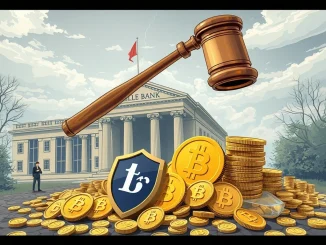
In a surprising turn of events, the stablecoin giant Tether, often a subject of scrutiny, is now positioning itself as a pillar of strength for the U.S. economy. At a recent Bitcoin Policy Institute event, Tether’s CEO, Paolo Ardoino, dropped a bombshell: Tether holds a staggering $115 billion in US Treasury bonds. His bold claim? This massive investment significantly bolsters US debt resilience. But is this just PR spin, or is there real substance to this assertion? Let’s dive deep into Tether’s power move and explore the implications for the crypto world and beyond.
Tether’s Bold Bet: $115 Billion in US Treasury Bonds
Imagine a cryptocurrency company holding more US Treasury bonds than many nations. That’s the reality with Tether. But what exactly are these bonds, and why are they so crucial?
Understanding US Treasury Bonds: The Bedrock of Global Finance
- What are they? US Treasury bonds are debt securities issued by the U.S. government to finance its spending. Think of it as lending money to the U.S. government.
- Why are they considered safe? They are backed by the full faith and credit of the United States government, making them among the safest investments globally.
- Role in the financial system: They serve as a benchmark for interest rates worldwide and are a cornerstone of the global financial system.
- Demand Drivers: Central banks, sovereign wealth funds, and large institutions heavily invest in US Treasury bonds for their safety and liquidity.
Tether’s portfolio, primarily backing its stablecoin USDT, has increasingly leaned towards these safe-haven assets. This shift is significant, moving away from earlier concerns about the composition of Tether’s reserves.
Does Tether Really Fortify US Debt Resilience?
Now for the million-dollar question: can a stablecoin issuer like Tether genuinely impact the US debt resilience? Paolo Ardoino certainly thinks so. Let’s break down his argument and analyze the potential impact.
Ardoino’s Argument: A Vote of Confidence in US Debt
- Massive Investment: $115 billion is not a small sum. It represents a significant demand for US Treasury bonds.
- Diversification of Holders: Tether, as a major non-traditional holder, diversifies the base of investors in US debt.
- Signal of Stability: A large stablecoin investing heavily in US Treasury bonds can be interpreted as a sign of confidence in the US economy and its debt.
- Liquidity Provision: Tether’s holdings contribute to the overall liquidity of the US Treasury bonds market.
However, it’s crucial to consider the nuances:
While $115 billion is substantial, it’s a fraction of the overall US debt market, which is in the trillions. The total US debt is massive, and while Tether’s holding is significant for a private company, its direct impact on overall US debt resilience might be overstated.
Potential Challenges and Counterarguments:
- Scale Relative to US Debt: The US debt market is enormous. Tether’s holdings, while large for a crypto entity, are a small percentage of the total outstanding debt.
- Indirect Impact: The effect might be more indirect, influencing market sentiment rather than directly propping up US debt resilience.
- Tether’s Own Stability: Concerns about Tether’s reserves and operations have existed in the past. Its stability is paramount for its claims to hold weight.
- Market Volatility: While US Treasury bonds are safe, market fluctuations can still impact their value, and consequently, Tether’s reserves.
Paolo Ardoino: Tether’s Visionary CEO on the Global Stage
Paolo Ardoino, Tether’s CEO, has been increasingly vocal about the company’s role and vision. His appearance at the Bitcoin Policy Institute event underscores Tether’s growing engagement with policy and regulatory discussions.
Key Takeaways from Ardoino’s Statements:
- Transparency Push: Ardoino has emphasized Tether’s commitment to transparency regarding its reserves.
- Beyond Crypto: His comments suggest a broader ambition for Tether, positioning it as a significant player in the global financial landscape, not just within the crypto niche.
- Regulatory Engagement: By participating in policy events, Ardoino signals Tether’s willingness to engage with regulators and policymakers.
- Defense of USDT: He consistently defends USDT’s peg and stability amidst market scrutiny.
Paolo Ardoino‘s proactive approach is reshaping Tether’s image. From a controversial stablecoin issuer, Tether is attempting to evolve into a more mainstream and respected financial entity. His claim about US debt resilience is a bold move in this direction.
The Broader Implications: What Does This Mean for Crypto and Finance?
Tether’s massive US Treasury bonds holdings and CEO’s statements have ripples across the crypto and traditional finance sectors.
Impact on the Crypto Market:
- Increased Legitimacy: Tether’s large holdings of US Treasury bonds could enhance the perceived legitimacy of stablecoins and the broader crypto market.
- Reduced FUD (Fear, Uncertainty, and Doubt): Transparency about reserves and investment in safe assets can alleviate some of the persistent FUD surrounding Tether.
- Benchmark for Stablecoins: Tether’s strategy could become a benchmark for other stablecoin issuers, pushing them towards safer and more transparent reserve management.
Impact on Traditional Finance:
- Crypto-Finance Intertwining: This development highlights the increasing interconnectedness of crypto and traditional finance.
- New Source of Demand for US Debt: Stablecoin issuers could become a non-traditional but significant source of demand for US Treasury bonds.
- Regulatory Scrutiny: The scale of Tether’s holdings will likely attract further regulatory attention to stablecoins and their role in the financial system.
Conclusion: Tether’s Calculated Risk or Genuine Support?
Tether’s claim that its US Treasury bonds holdings bolster US debt resilience is a powerful statement. While the direct impact might be debatable, the symbolic and strategic implications are undeniable. It’s a power move that attempts to redefine Tether’s narrative and solidify its position in the global financial ecosystem.
Whether it’s a calculated PR strategy or a genuine contribution to US debt resilience, Tether’s actions are forcing a re-evaluation of stablecoins and their potential role in the broader economy. As the crypto landscape matures, expect to see more such unconventional intersections with traditional finance, blurring the lines and challenging established norms. Keep a close watch on Tether’s reserves and its evolving relationship with global finance – it’s a story that’s far from over.



